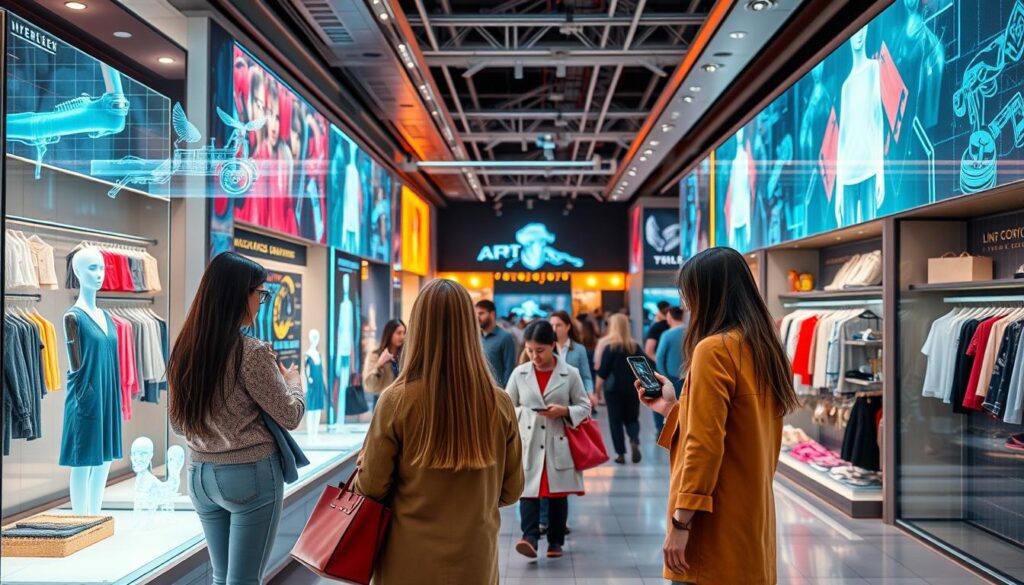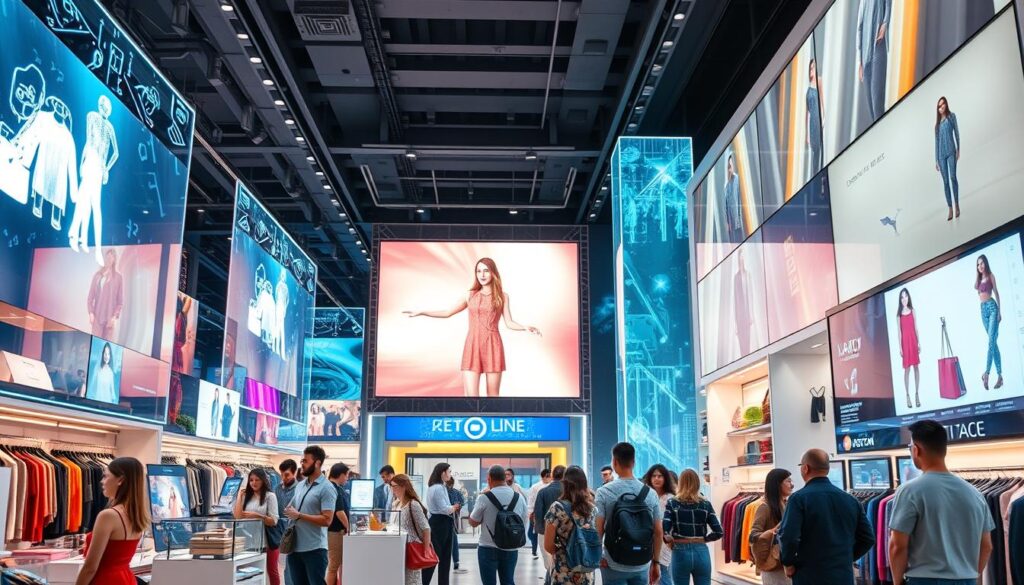AI-driven augmented reality is transforming how we shop online. It lets customers see products in their space before buying. Retailers use AI and AR to create engaging, lifelike shopping experiences. This innovation makes online shopping feel like you’re in an actual store, but better. It learns what you like, making shopping personalized and fun. This change makes customers happier and more involved.
Key Takeaways
- AI in eCommerce: Enhances customer interaction by offering more immersive and interactive shopping experiences.
- Augmented Reality Shopping: Allows customers to visualize products in customizable, realistic settings.
- Future of Retail Tech: Integrates AI and AR to bridge the gap between physical and digital realms.
- AI Shopping Experience: Personalizes each user’s shopping journey according to their behaviors and preferences.
- Retail technology advancements are significantly increasing customer satisfaction and engagement.
The Rise of AI in Augmented Reality for eCommerce
The world of eCommerce is rapidly changing with the blend of Artificial Intelligence (AI) and Augmented Reality (AR). This mix has revolutionized shopping and influenced how we buy things. As these technologies grow, we’re seeing new trends in AI-driven AR that change the way we shop online.
Historical Context
In the beginning, AR made it easier to see products in 3D, but it didn’t offer custom experiences. Shoppers could interact with products more realistically than with photos or videos. However, it was the same experience for everyone, lacking the personal touch we now crave.
Then, AI changed everything. ADA, a company working across 12 Asian markets, used AI to make shopping personal. They helped over 1,500 clients, including those in retail, by personalizing the shopping experience with their AI CoPilot for Ecommerce.
Emerging Trends
The journey of AI in AR is still ongoing. Now, we see AI in AR Development changing how we shop by making it more immersive and personal. ADA’s AI CoPilot is a key innovation. It quickly adapts to market changes in pricing and demand, thanks to real-time analytics.
AI is also becoming smarter at understanding how people shop within AR Development environments. It leads to better product suggestions and shopping experiences that meet users’ needs. ADA’s AI tools for marketing and customer analysis illustrate how AI is transforming customer interaction.
The pairing of AI and AR in eCommerce is moving us forward. With continuous innovation from companies, the future holds even more personalized and engaging shopping experiences for everyone.
Enhanced Customer Engagement Through Personalized Experiences
In today’s eCommerce world, keeping customers engaged is key. Businesses are using AI Personalization in Retail to craft immersive and personalized shopping experiences. These experiences grab the attention of shoppers.

Immersive Shopping Experiences
AI is changing the way we shop online. It’s enabling immersive eCommerce that’s dynamic and fun. For example, augmented reality (AR) lets customers see products in their space before buying. This innovative approach is used by top retailers to make shopping more interactive and intuitive.
Moreover, companies like Netflix use AI to keep viewers engaged. They improve viewer retention by 75% with personalized recommendations. This shows how crafting experiences for each consumer builds deeper connections.
Personalization Algorithms
At the heart of personalized shopping are smart algorithms. These algorithms look at what users like, their browsing habits, and what they’ve bought before. By doing so, they can show products that truly interest each customer. Big companies like Amazon and Alibaba excel in this, making sure shoppers see what they’re most likely to buy.
This boosts the chances of sales and keeps customers coming back. Consumer engagement strategies powered by AI make shopping feel special and tailored for everyone.
AI now influences up to 35% of sales in various sectors, showing its huge role in commerce. Companies like ADA, backed by a $58 million investment from Mitsui & Co., Ltd., are leading in AI. Their AI CoPilots assist in marketing, e-commerce, and understanding customer groups. This investment highlights the big opportunities in AI-personalized retail.
“AI augments backend operations, enhancing security and performance monitoring, thereby revolutionizing eCommerce development and web design, particularly in tech hubs like Dubai.” – Tech Analyst
AI in personalized shopping elevates customer happiness and sets companies apart from those sticking to old ways. The goal is to build an immersive eCommerce world. This world keeps customers constantly engaged and loyal.
AI-Driven Augmented Reality (AR) in eCommerce
Artificial Intelligence (AI) is changing eCommerce with augmented reality (AR). AI and AR combine to make shopping more personalized and immersive.
Case Studies
Examining AR in real-world scenarios shows how AI and AR make retail strategies work better. For instance, Nextech3D.ai has changed how big online stores like Amazon show products. They use a tool called FotoGPT. It makes super real 3D models of products. This helps shoppers see products better and cuts down returns.
ADA, a big name in data and AI, works in 12 Asian markets and has over 1,500 clients. They have over 1,400 employees. ADA’s AI CoPilots do many things like help with online marketing and make online shopping better. They help in talking with customers and figuring out who to sell to. About 100 clients are already using these tools.
In Japan, Mitsui & Co., Ltd. put US$58 million into ADA in 2023. This made ADA worth US$550 million. ADA plans to start working in the U.S. soon. This move will share these AI tools with more people, improving online shopping even more.
These examples show that AI and AR are being used in real shops to make big changes. They’re not just ideas. They are making a big difference in how we buy things online.
Reducing Return Rates with 3D and AR Visualization
Advanced 3D and AR visualization technologies have made it easier to lower return rates in eCommerce. Customers can now virtually try products before buying them. This increases their confidence and happiness. The use of technologies like Nextech3D.ai’s FotoGPT helps reduce eCommerce returns. They make products look real in the customer’s space, matching expectations with reality.
The need for AR Visualization is growing, especially in places like New York City. Here, fashion meets technology. Virtual fitting rooms use AR and machine learning to change how we shop online. Businesses use data to make smarter choices about what to make and sell. This makes sure what customers expect is what they get, lowering return rates.
3D Modeling also greatly improves customer happiness. It helps shoppers feel more sure about their buys by showing realistic product views. Fashion brands in New York use AI to make shopping personal and keep customers coming back. Adopting these technologies lowers returns and supports green practices by cutting waste. By using these visual techs, online stores offer a better, clearer shopping journey. This keeps customers happy and loyal, decreasing the number of returns.
FAQ
How is AI-driven augmented reality revolutionizing eCommerce?
What historical context led to the rise of AI in augmented reality for eCommerce?
What are the emerging trends in AI and AR for eCommerce?
How do immersive shopping experiences enhance customer engagement?
What role do personalization algorithms play in AI-driven AR platforms?
Can you provide examples of successful AI-driven AR implementations in eCommerce?
How does AI-driven AR help reduce return rates in eCommerce?
Source Links
- https://techbullion.com/transforming-software-engineering-innovations-in-optimization-quantum-computing-and-user-centric-design/
- https://forbesasiacustom.com/from-data-to-impact-how-ada-is-revolutionizing-digital-commerce-in-asia/
- https://theinscribermag.com/ai-role-web-design-development-dubai/
- https://www.techloy.com/how-mobile-technology-is-revolutionising-entertainment-online/
- https://www.entrepreneur.com/en-in/technology/preparing-for-wi-fi-7-and-beyond/482592
- https://vocal.media/journal/leading-saudi-software-companies-driving-innovation-in-web-mobile-and-ai-development
- https://www.newscentralasia.net/2024/11/08/top-e-commerce-trends-in-2024/
- https://techbullion.com/the-influence-of-new-yorks-tech-scene-on-the-fashion-industry/
- https://www.mdpi.com/2673-4591/79/1/64



